If you buy 75/25 argon/CO2 from Linde, you’ll want to know actual costs by cylinder size, refill option, and local market — prices can vary more than you expect. I’ll walk you through typical 125–300 cu ft pricing, exchange versus refill economics, and how to calculate your annual gas spend so you can compare suppliers and avoid surprises. Ready to see which option saves you the most?
Common Uses for 75/25 Argon/CO2 in Welding
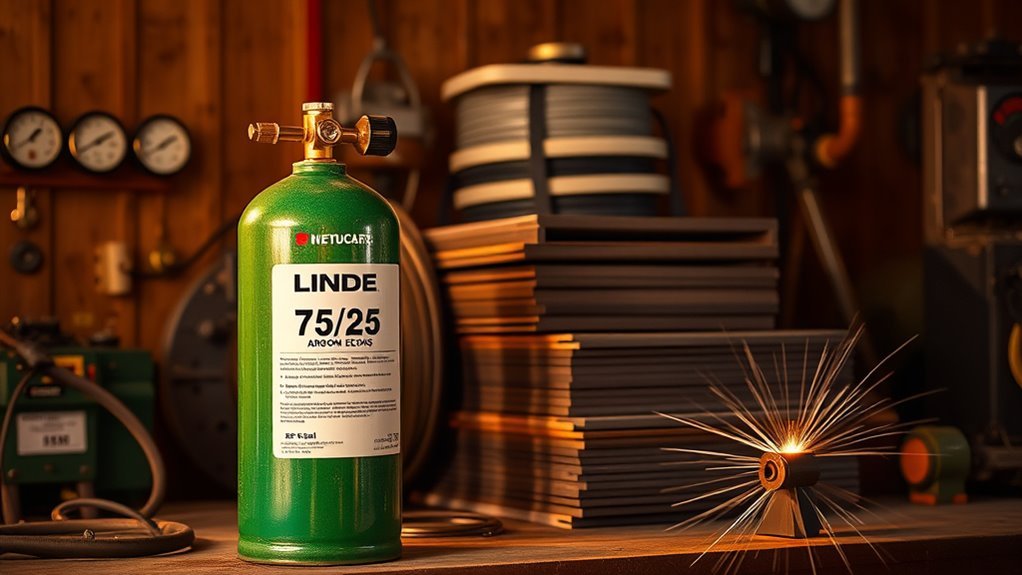
While welding mild steel, you’ll find the 75/25 Argon/CO2 mix gives a stable arc and deep penetration that lets you control bead shape and heat input precisely.
You’ll reach for this gas mixture when you need consistent, low-spatter results across common welding applications like sheet metal assembly, automotive body repair, and light fabrication.
You’ll appreciate how the blend minimizes distortion on thin gauges while still delivering the higher penetration required on thicker joints, so you can adjust travel speed and wire feed without sacrificing weld quality.
Appreciate reduced distortion on thin gauges and reliable penetration on thicker joints—adjust travel and wire feed confidently without compromising weld quality.
When working on certain stainless steels or shifting between panel work and structural tack-ups, this mix offers predictable fusion and easy cleanup.
Plan your parameters around its thermal balance: reduce voltage slightly on thin material and increase wire feed for thicker sections.
In shop settings where finish and efficiency matter, choosing the right gas mixtures like 75/25 simplifies setup, shortens grinding time, and improves first-pass acceptability.
Typical Cylinder Sizes and Price Ranges
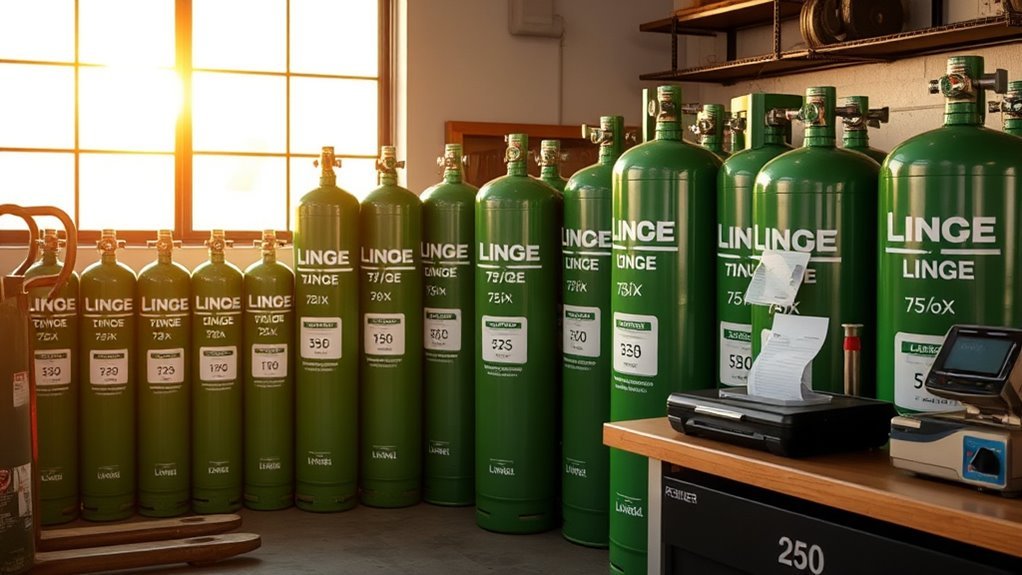
Now that you know why 75/25 Argon/CO2 works well for many shop jobs, you’ll want to match that choice to the right cylinder size to keep costs and downtime under control. You’ll find Linde offers common cylinder sizes that move the needle differently on cost per cubic foot, so plan around your weld volume and storage capacity.
| Cylinder Size | Typical Use | Price Range |
|---|---|---|
| 40 cu ft | Light/occasional shop work | $60–$70 |
| 125 cu ft | Regular daily use | ≈ $116 |
| 300 cu ft | High-volume shops | ≈ $96 (argon example) |
Compare local suppliers because regional supply and demand shifts these price ranges. Smaller cylinders cost less up front but raise unit costs if you refill frequently. Larger cylinders lower per-unit cost and reduce downtime, but you’ll need space and handling capacity. Choose the cylinder sizes that balance working hours, storage, and cash flow.
How Refill Costs and Exchange Programs Work

Because refill and exchange options change your per‑weld cost and maintenance burden, you should compare them closely before committing, especially if you move a lot of gas or manage multiple bottles.
You’ll see refill pricing differences immediately: Linde typically charges more to refill non‑exchange cylinders, and a recent 125 CF 75/25 refill was around $116.19, illustrating how refill fees can climb.
Choosing an exchange program delivers clear exchange benefits — you sidestep hydrostatic test costs because supplier‑maintained bottles arrive certified and ready.
Choosing an exchange program saves you hydrostatic test hassle — supplier‑maintained bottles arrive certified and ready.
Strategically, weigh the savings against access limits: exchange tanks may force you to use designated refill locations, which impacts logistics and downtime.
Ask local Linde reps about exact refill pricing, exchange policies, and any handling or transport fees.
If you run high throughput or manage many bottles, exchange often lowers per‑weld costs and administrative load; if you need flexibility or specific fittings, non‑exchange refills might still make sense.
Regional Price Variations and Recent Quotes

Regional market swings can cut or raise your welding gas bill by dozens of dollars per cylinder, so check local quotes before you commit to a supplier or program. You’ll see Linde quotes near $120 for a 300 cf 75/25 cylinder, but nearby markets differ sharply. In East Tennessee a 300 cf Argon price was reported at $72; Airgas quoted Argon at $73 and C25 at $78. Members in Michigan noted a 330 cf Argon as low as $54 plus hazmat. Those variations matter when you optimize welding techniques, scheduling, and gas storage to reduce run-time costs.
| Location | Recent Quote |
|---|---|
| Linde (various) | $120 (300 cf) |
| East Tennessee | $72 (300 cf Argon) |
| Airgas | $73 Argon / $78 C25 |
| Michigan (member) | $54 + hazmat (330 cf Argon) |
| Note | Check local supply and demand |
Use these quotes tactically: compare exchange vs refill, verify hazmat fees, and lock short-term contracts when regional supply tightens.
Calculating Your Real Annual Gas Cost
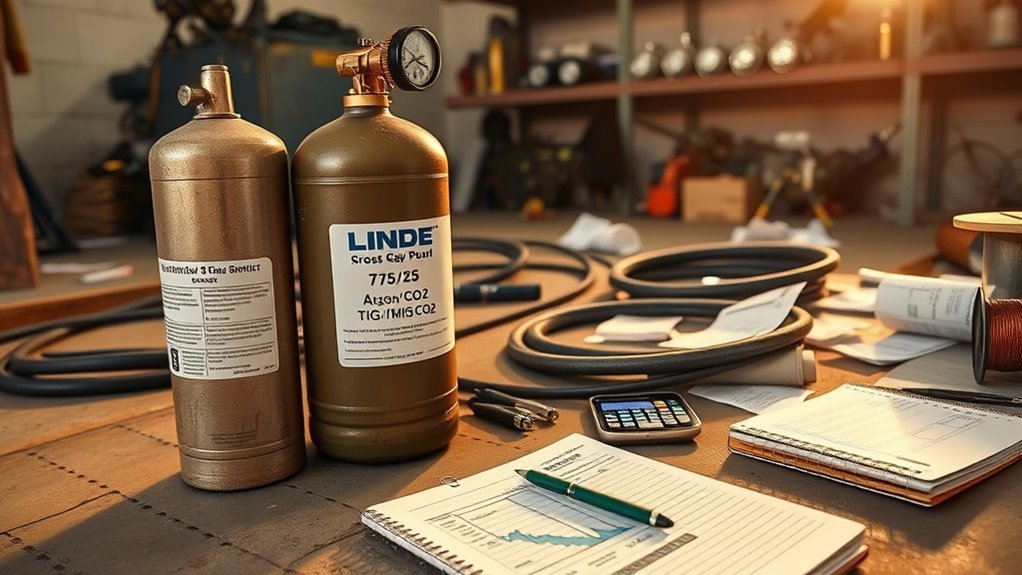
Those price snapshots show why you can’t treat sticker prices as the whole story when calculating annual gas cost — you need a firm grasp of refill cadence, tank sizes, and one-time purchases to see the true expense.
Sticker prices mislead — factor refill cadence, tank size and one-time purchases to reveal true annual gas costs
You should itemize initial tank purchase separately from recurring refills: a 125 CF filled at about $116.19 (up from $63.11) creates a baseline, then factor refill frequency — quarterly refills yield roughly $280 a year after that first purchase.
Compare per-refill economics: 40 CF at ~$60, 80 CF at ~$70, and 125 CF at a higher single cost can make larger cylinders more cost-effective over time.
Include regional supplier variation — Linde vs Airgas — in your cost analysis and run simple annualized comparisons to pick the best tank size and refill cadence.
Match your welding techniques and expected run time to that plan, and you’ll avoid surprises and tighten budget forecasts.
How Long a Cylinder Lasts at Different Flow Rates
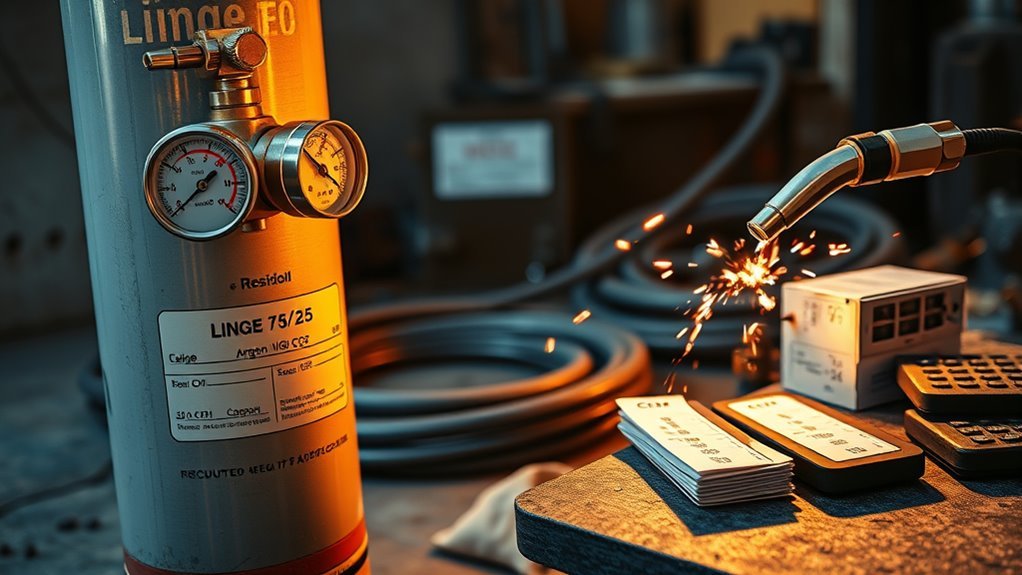
When you match tank capacity to your typical flow rate, you get a reliable estimate of run time and can plan refills instead of reacting to downtime.
Calculate cylinder duration by dividing tank volume by your chosen flow rate: an 80 CF tank at 10 CFH gives about 8 hours, while the same tank at 40 CFH runs roughly 2 hours.
Since flow rates commonly span 10–40 CFH, you can quickly map run times for each job and schedule work around real cylinder duration.
Use the pressure gauge to refine estimates — a full tank reads about 2015 psi and a half-spent tank near 1000 psi — but remember psi-to-volume isn’t perfectly linear as temperature and regulator settings matter.
If a cylinder sits unused, rolling it horizontally before service helps recombine any slight gas separation without stressing the valve.
Track average flow rate per project and keep a simple reference table so you’re never guessing remaining weld time.
Tips for Buying, Leasing, and Refilling Safely
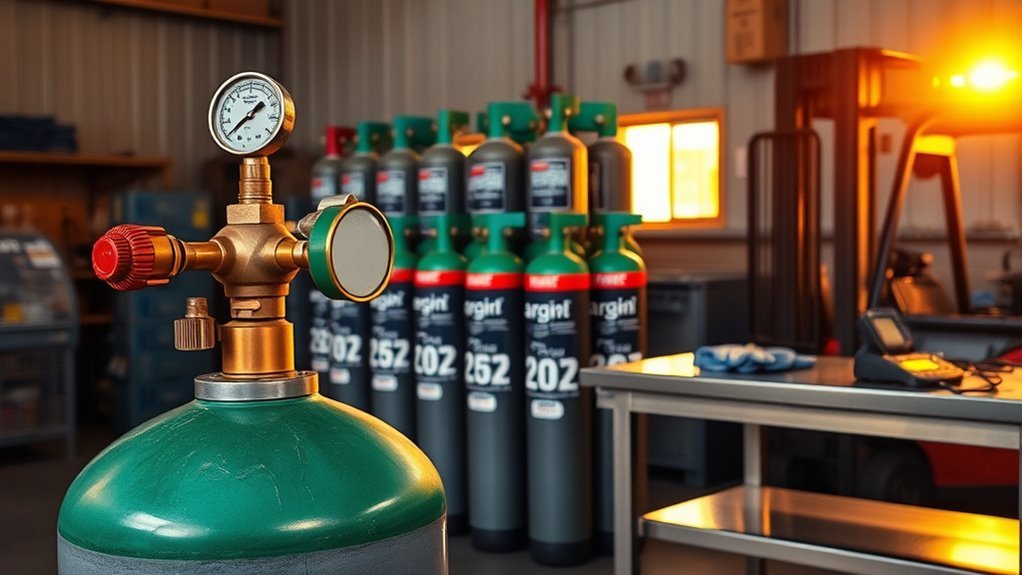
When you handle cylinders, secure them upright, use appropriate regulators and caps, and inspect DOT certification and valves before each use to prevent leaks and guarantee compliance.
Weigh the costs of leasing versus buying: leasing cuts upfront expense and simplifies refills and exchanges at Linde locations, while buying can be cheaper long-term if you need high-capacity tanks like 300 CF.
Plan refill frequency around tank size and local pricing — ask your Linde rep about exchange programs and regional rates to optimize safety and cost.
Safe Cylinder Handling
Anyone handling welding gas cylinders should treat them like pressurized tools—inspect DOT certification and the date stamp to confirm they’re within the 10-year refill window, check for dents, rust, or valve damage, and plan for secure, upright transport using proper lifting techniques and restraints to prevent tipping or rolling. You’ll perform cylinder inspection systematically, wear gloves and goggles, and never modify cylinders yourself. Store upright in ventilated areas, away from heat and flammables. When refilling, confirm the supplier follows safety protocols and inspects for corrosion. Be strategic: label full/empty, cap valves during moves, and keep spill response ready.
| Task | Frequency | Responsibility |
|---|---|---|
| Inspection | Before refill | You/Supplier |
| Transport | Every move | You/Carrier |
| Storage | Daily check | You/Site Manager |
Lease vs. Buy
Because your choice affects both cash flow and long-term cost, weigh leasing against buying with your usage pattern and safety needs in mind.
If you need low upfront expense and flexible swaps, leasing benefits include smaller initial outlay and easy exchange programs; just track ongoing rental fees and refill pricing to avoid surprises.
For steady, high-volume work, purchasing considerations favor buying a properly sized tank—larger volumes like 300 CF lower per-refill costs and reduce downtime.
Always compare refill structures between leased and owned cylinders and confirm local supplier exchange restrictions.
Before any refill or exchange, verify DOT certification and supplier safety standards. That way you balance short-term budget needs against long-term economy and regulatory compliance.
Alternatives to 75/25 and When to Use Them
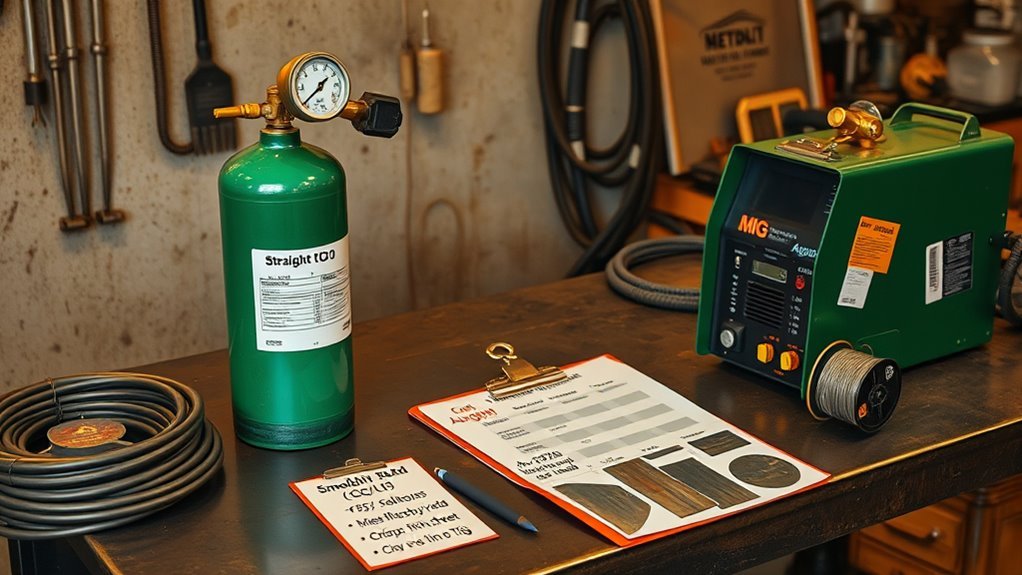
When 75/25 isn’t the right fit, you should consider flux‑cored wire for outdoor MIG work to avoid gas issues and still get good fill and deposition.
For TIG on aluminum or whenever you need cleaner, quieter arcs, pure argon gives the control and surface finish you want.
And for steel or stainless jobs that need tighter arc control or deeper penetration, small oxygen‑added blends or argon/helium mixes can be the strategic choice depending on thickness and bead profile.
Flux‑Cored Alternatives
If you need a reliable alternative to 75/25 MIG welding—especially for outdoor or heavy‑duty work—flux‑cored wire deserves serious consideration, since it eliminates external shielding gas and keeps you welding in wind or on thick sections without constantly topping off bottles.
You’ll appreciate flux cored advantages: self‑shielded wires give deep penetration on thicker plates and tolerate drafts that wreck gas‑shielded MIG.
Expect more spatter but higher deposition rates, so you finish joints faster on structural and fabrication work.
You’ll save on gas costs for large jobs and choose from formulations matched to different base metals, which boosts welding versatility.
Use flux‑cored when portability, joint thickness, and economy outweigh the cleaner appearance and lower spatter of 75/25.
Pure Argon Benefits
Switching from flux‑cored to gas-shielded processes means thinking about the gas itself, and pure argon offers clear advantages for applications that demand cleaner, more controlled arcs.
You’ll choose argon applications like GTAW and plasma cutting when oxidation must be prevented—aluminum and non‑ferrous work benefit most.
Pure argon gives a stable, focused arc that improves welding quality on intricate joints and stainless steel, reducing porosity and contamination.
For thicker sections where penetration matters, you can pair argon with helium to boost heat input without introducing reactive species.
Strategically, reserve pure argon for precision, aesthetic, or corrosion‑sensitive jobs and use mixtures only when you need extra weld pool energy; that approach optimizes cost versus performance.
Oxygen‑Added Blends
Although argon‑oxygen blends like 80/20 still rely on inert carrier gas, the added oxygen gives you a sharper, more stable arc and better heat concentration than a straight 75/25 mix.
You’ll see oxygen benefits in improved penetration, reduced spatter, and faster travel speeds that minimize distortion on thin stainless.
But the oxygen can change mechanical properties, so you must weigh blend considerations against metallurgical needs.
- Use 80/20 for stainless MIG when you need deeper penetration and cleaner beads.
- Choose lower oxygen if toughness or specific mechanical properties are critical.
- Opt for oxygen-added blends to reduce heat input and control warping on thin sections.
- Consult your supplier to confirm compatibility with wire, machine settings, and base metal.
How to Shop Local Suppliers and Compare Linde Quotes

Wondering how to get the best price on Linde 75/25? Call local suppliers, request quotes for Linde’s 75/25 Argon/CO2 mix, and track regional differences carefully—pricing strategies vary by territory and vendor.
Start by comparing Linde’s quote (recent reports put a 125 cu.ft bottle near $116) with competitors like Airgas; some welders find Linde pricier. Ask each supplier about exchange program policies and whether you’ll face higher refill charges for non-exchange bottles—those fees can skew total cost.
Discuss supplier relationships candidly: tell them your usage, ask about volume discounts, and explore business account terms that often reveal better rates for frequent users. Get itemized quotes so you can compare bottle deposit, refill, delivery, and surcharge lines.
If one supplier won’t budge, use competing bids to negotiate. Keep a short spreadsheet of quotes, dates, and contact names so you can revisit pricing and secure the best deal when market shifts occur.
Frequently Asked Questions
Is 75/25 Safe to Store in a Home Garage Long-Term?
No, you shouldn’t store 75/25 long term in a home garage; you’ll follow safety precautions: secure cylinders upright, ventilate, keep away from heat/sparks, label and inspect regularly, and consider professional storage or offsite long term storage options.
Can I Mix Leftover Gases From Different Brands Safely?
Like mixing paints, you shouldn’t—you’ll risk gas compatibility concerns and unpredictable performance; follow brand safety standards, consult supplier specs, and separate cylinders to stay strategic, experienced, and detail-oriented to avoid dangerous reactions or contamination.
Do Welding Shops Accept Partial-Cylinder Trade-Ins?
Yes — many shops accept partial-cylinder trade-ins if their partial trade policies allow it; you should ask about cylinder exchange options, fees, credit for remaining gas, and documentation to guarantee the trade is strategic and cost-effective for you.
How Does Temperature Affect Cylinder Pressure Readings?
You’ll see cylinder pressure change as temperature effects alter gas density; warmer temps raise pressure, colder temps lower it, so you’ll monitor readings, adjust usage or regulator settings, and plan storage to maintain safe, accurate pressures.
Are There Special Permits for Transporting Large Cylinders?
For a municipal project, you’d need DOT permits; you’ll follow transport regulations and guarantee cylinder labeling is intact. You’ll coordinate routes, secure documentation, and schedule inspections to meet safety and legal requirements.
Conclusion
You’re not just buying gas—you’re buying peace of mind for every weld, and with Linde’s 75/25 you’ll get reliable shielding without breaking the bank. Prices vary—think roughly $116 for 125 cu ft and about $120+ for larger cylinders—so check local dealers, compare refill vs. exchange, and factor in flow rates to calculate annual cost. Be strategic: buy the right size, watch regional quotes, and you’ll never run out mid-job or overpay for performance.


